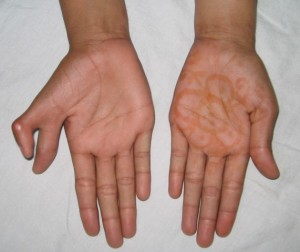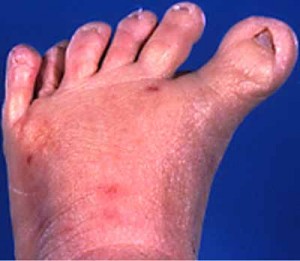Have you ever seen a person with an extra finger or toe and wondered what the condition could be? It is a type of Polydactyly that the individual is probably suffering from. Read and know all about this disorder, including its causes, symptoms, diagnosis and treatment measures.
Polydactyly Definition
Page Contents
It is the name given to a congenital physical deformity, or birth defect, which is characterized by the presence of more than five fingers or toes.
The condition is also referred to as “Polydactylism” or “Hyperdactyly.” It is the opposite of a condition known as Oligodactyly that is marked by the presence of fewer fingers or toes. The additional abnormal projections of the body are also referred to as “Supernumary digits” or “Extra digits”.
Polydactyly Etymology
The name of this birth defect comes from the fusion of two Greek terms of ancient origin – “Polys” standing for “many” and “Daktylos” meaning “finger.”
Polydactyly ICD9 Code
The ICD9 Code for this defect is 755.0.
Polydactyly Symptoms
As already mentioned, the condition is marked by the presence of additional number of digits – i.e, toes or fingers. The extra digits are sometimes referred to as supernumary, clearly referring to the fact that they exceed the number of digits that can be conventionally found.
The additional digits can assume various forms. They commonly arise as a tissue stub without any joints and are usually situated adjacent to the little finger or toe. In some people, the additional digit comprises of articulated joints and bones and can be used like normal digits.
Rare forms of Preaxial Polydactyly have been found to give rise to certain additional problems like:
- Cardiac abnormalities
- Blood disorders
- Craniofacial abnormalities
The condition can make X-ray images appear quite abnormal and even confusing. However, the main problems resulting from this type of defect are those of functioning and appearance. The functioning of the additional digits and the rest of the extremity are the prime issue. Their abnormal appearance, although the secondary problem, are also responsible for affecting the psychology of sufferers.
Polydactyly Types
This birth defect can be of different types. These include:
Thumb Polydactyly
Some individuals have polydactyl thumbs. In this condition, there are dual thumbs on the same hand. They are typically placed immediately adjacent to each other. Some people suffer from a duplication of the additional bone in the thumb while some others suffer from a duplication of the middle bone.
It is also referred to as Thumb duplication, Preaxial or Radial Polydactyly.
Central Polydactyly
It is also known by the name “Central Duplication.” This is marked by the duplication of the middle, ring or index finger of affected people. It occasionally arises with webbed or fused fingers – a condition known as Syndactyly. The Central form often affects both hands and is frequently also found to arise along with syndactyly. The ring finger is the most affected by duplication, followed by the long finger and then the index finger.
Small Finger Polydactyly
This is the most common type of Polydactyly and is 8 times more common than the previous forms. It often affects both hands. It is also known by the name Small Finger Duplication, Postaxial or Ulnar Polydactyly. As the name suggests, it is characterized by the duplication of the small finger. In other words, there are two small digits in the hand or the foot instead of one.
Polydactyly Incidence
This is the most common type of congenital defect of the hand and foot. It is said to affect around five out if every 10,000 babies. While the Postaxial form is the most common, the central and preaxial forms have lower prevalence. The Preaxial form arises in one out of every 3000 births.
Polydactyly Causes
The condition may have a genetic association. The susceptibility to the defect is increased if both parents have it. However, it has also been found to occur without any apparent genetic association. If a child does not have any other physical problems, the defect may not affect his or her mental or physical development in any way. If both parents carry the dominant genetic trait of this disease, children have 75% risk of acquiring it. If both parents have the recessive trait, children have a 25% risk of inheriting the disease.
The defect results from an error in the genes that determine the shape of the foot or the hands. In some people, it is caused due to an isolated case of genetic inheritance. In a few others, it is the result of abnormal genetic actions during the development of the fetus. In others, it may be a part of aneuploidy – another genetic condition characterized by the presence of an abnormal number of chromosomes that may give rise to severe birth defects.
This birth defect may also be the consequence of the following conditions:
- Trisomy 13
- Familial polydactyly
- Carpenter syndrome
- Rubinstein-Taybi syndrome
- Smith-Lemli-Opitz syndrome
- Asphyxiating thoracic dystrophy
- Laurence-Moon-Biedl syndrome
- Ellis-van Creveld syndrome (Chondroectodermal dysplasia)
In extremely rare cases, Polydactyly is found to be a part of a rare and complex inherited disease known as Laurence-Moon-Bardet-Biedl Syndrome.
The disorder has also been observed to have a racial preference. People belonging to the African American community are at more risk of inheriting an additional finger than all the other ethnic groups. As the gene causing this anomaly is a dominant one, a child with one parent carrying the trait has a 50% risk of inheriting it.
The condition is not found to show a sexual predilection as both males and females are equally affected by the defect.
Polydactyly Diagnosis
The defect is typically detected with the aid of external physical examination, x ray test and a fetal sonogram. Some other tests, occasionally used to detect the underlying cause for the problem, might involve:
- Metabolic studies
- Enzyme tests
- Chromosome studies
In pregnant women, the defect may be diagnosed by an ultrasound examination. In some cases, a further advanced exam known as embryofetoscopy may be used – especially during the initial three months of maternity (first trimester).
Polydactyly Treatment
Usually, this birth anomaly does not need any treatment. In most cases, although physically conspicuous, they are not too pronounced and only look like a fleshy stump. Treatment, if needed, consists of:
Psycholical support and counseling
In case of a prominent defect, affected individuals may get socially withdrawn as a consequence of being differently treated in the early years of their life. As a child enters his teen years, he or she becomes more conscious of his body and become psychologically depressed due to a different appearance than their peers. In such cases, psychological counseling may be needed. Parents should also be supportive and shower more love and care on their affected kids to make them feel emotionally secure. Surgery may be needed in cases where an extra digit begins to impair functions and daily life to a significant extent. For example, an extra digit on the foot may make it difficult for shoes to fit. In such circumstances, surgical removal of the additional toe is the best and most sensible option.
Surgery
An operative cure for Polydactyly differs on the basis of the type of the condition that one suffers from. If an individual is affected by the Preaxial form, a single thumb can be reconstructed from two split (duplicated) thumbs. The method of creation of a single thumb involves reconstruction of:
- Skin
- Tendons
- Joints
- Soft tissues
- Ligaments
In people with the postaxial form, the additional limb is attached only by a narrow stalk comprising of soft tissue. This has to be removed by a small operative technique. However, if the stalk is quite narrow, treatment may involve its ligation.
In case of a well-developed digit, surgery is more involved. The operation, in such cases, may involve as comprehensive a reconstruction as adapted in the treatment of the preaxial form.
The central form of the condition needs to a complicated operative method, if a finger needs the reconstruction. The joints, ligaments, soft tissues and tendons need a reconstruction. In certain individuals with the central form, more than one surgery is needed.
The operative treatment, for correction of this congenital defect, usually requires a certified therapist and an expert surgeon. Sometimes, a developmental pediatrician and a geneticist also need to be involved for caring after babies exhibiting this type of defect.
Ligation
In this method, the extra mass of skin or stalk attached to the normal finger or toe is bound with a piece of string. This cuts off the supply of blood and nutrients to the affected region and causes it to fall off after a period of time.
Polydactyly Complications
Fortunately, individuals with this defect are not found to suffer from any complications or disorders later in their life due to the physical anomaly. However, affected people may suffer from social withdrawal and other similar problems resulting from consciousness of their body image.
Polydactyly in Cats
The condition is quite common in cats and is believed to arise as a result of genetic mutation. The disorder is primarily found in cats along the East coast of the U.S. A cat affected by this condition may have one or more additional digits on either foot, which makes the foot splayed and larger than usual in appearance.
The Hemingway cats (living on the erstwhile estate of Nobel-laureate American author Ernest Hemingway) in Florida, U.S, are well-known cats showing this birth defect. They exhibit the genetic association of the condition in felines as the defect is demonstrated in more than one generation of such cats.
A rare genetic variation of Polydactyly results in a deformity known as Radial Hypoplasia which is characterized by the malformation of radius, a long bone of the forepaw. This defect creates difficulties for affected cats to walk on their front legs. Cats showing such deformity are called “pixie-bobs” or “twisty cats.”
Polydactyly Pictures
Take a peek at these images to know how the condition affects the appearance of the extremities in humans and in cats.
Picture 1 – Polydactyly
Picture 2 – Polydactyly Image
If you are affected by this defect, you may consider surgical treatment if the extra digit is impairing your quality of life. Couples with either of the partners affected by this disorder should undergo genetic counseling to know whether it can arise in their child and how this physical anomaly can affect their baby.
References:
http://www.nlm.nih.gov/medlineplus/ency/article/003176.htm
http://www.bbc.co.uk/health/physical_health/conditions/polydactyly.shtml
http://www.genome.gov/27529688
https://runkle-science.wikispaces.com/Polydactyly


